|
|
|
| My Favourite Planet > English > People > Thucydides |
|
| |
Thucydides
Thucydides (Θουκυδίδης, Thoukydides; circa 460-395 BC) was a Greek politician, general and historian from Alimos (Άλιμος), an Attic deme on the west coast (on the Saronic Gulf), 7 kilometres south of Athens. He is sometimes referred to as "Thucydides the Halimousian" (Θουκυδίδης ο Αλιμούσιος). He also owned an estate including gold mines at Scapte Hyle, near Neapolis (today Kavala), on the Thracian coast of the Northern Aegean Sea, opposite the island of Thasos [1].
It was at Scapte Hyle that Thucydides spent his last years, following his banishment from Athens, and completed his work History of the Peloponnesian War ( Ιστορία του Πελοποννησιακού Πολέμου), an account of the war between Athens and Sparta and their allies in the 5th century BC (431-404 BC). Although quite different in style and approach to the Histories of Herodotus, it continues historically from where Herodotus left off, at the end of the Greek-Persian wars. In turn, the Athenian soldier and historian Xenophon continued the story in his own way [2].
"So little trouble do men take in the search after truth; so readily do they accept whatever comes first to hand."
Thucydides, The Peloponnesian War, Book 1, chapter 20, section 3. Translated by Benjamin Jowett. Clarendon Press, Oxford, 1881. At Perseus Digital Library. |
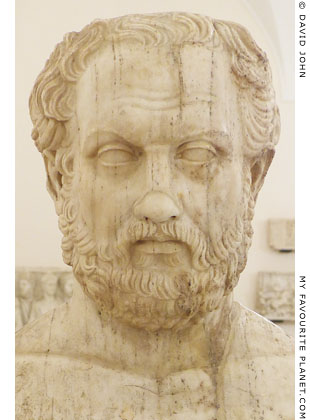
Marble bust of Thucydides.
From a double herm of Thucydides and
Herodotus, found in Hadrian’s Villa, Tivoli,
and now in the National Archaeological
Museum, Naples.
see details below. |
| |
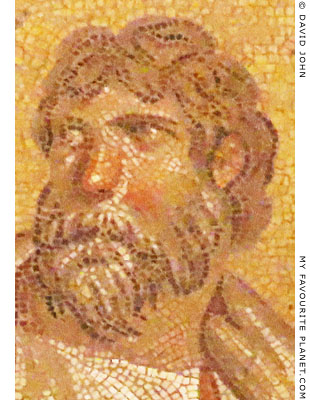
A bust of Thucydides on a Roman
period floor mosaic now in Berlin.
See details below. |
| |
| |

Marble head of Thucydides. 1-100 AD.
Ashmolean Museum, Oxford. On loan
from the Franziska Winters Collection.
Inv. No. LI1022.2. |
|
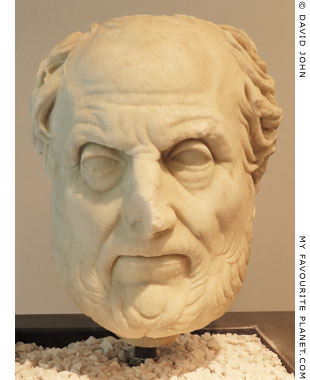
Marble portrait head, probably Thucydides.
The back of the head is missing.
Corfu Archaeological Museum.
Inv. No. 135.
Thucydides wrote one of the few surviving
accounts of the history of ancient Corfu
(Κόρκυρα, Korkyra) and the part the island
state played in the Peloponnesian War. |
|
| |
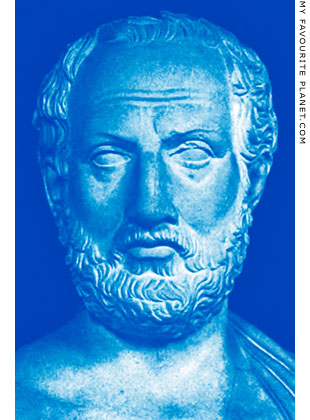
Marble bust of Thucydides.
Thought to be a Roman copy of
a bronze original, circa 300 BC.
Luna marble. Height 79.5 cm,
width 48 cm, depth 48 cm.
Holkham Hall, Norfolk, England.
At first believed to be a portrait of the
philosopher Metrodorus, the bust was
purchased in Rome by the architect
Matthew Brettingham for Thomas Coke,
1st Earl of Leicester (1697-1759), and
shipped to England on 7th March 1754.
Image source: Anton Hekler (1882-1940),
Greek & Roman portraits. Putman,
New York, 1912. At the Internet Archive. |
|
|
|
| |
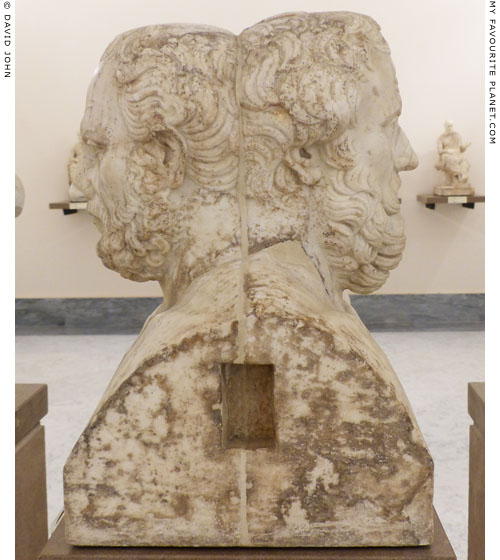
Side view of the double herm of Thucydides (left) and Herodotus in Naples.
The portrait heads are early 2nd century AD copies
of early 4th century BC Greek originals. Height 58 cm.
Found in Hadrian’s Villa, Tivoli, near Rome, around 1547-1555.
Later in the Farnese Collection in the Villa Farnesina, Trastevere,
Rome. Taken with the rest of the collection to Naples in 1787.
National Archaeological Museum, Naples. Inv. No. 6239. |
 |
|
|
| |
| |
 |
| |
 |
| |
 |
| |
 |
| |
 |
| |
 |
| |
George Alvanos
rooms in
Kavala's historic Panagia District
Anthemiou 35,
Kavala, Greece
kavalarooms.gr
|
| |
Olive Garden Restaurant
Kastellorizo,
Greece
+30 22460 49 109
kastellorizo.de
|
| |
Papoutsis
Travel Agency
Kastellorizo,
Greece
+30 22460 49 286
greeklodgings.gr
|
| |
| |
| |
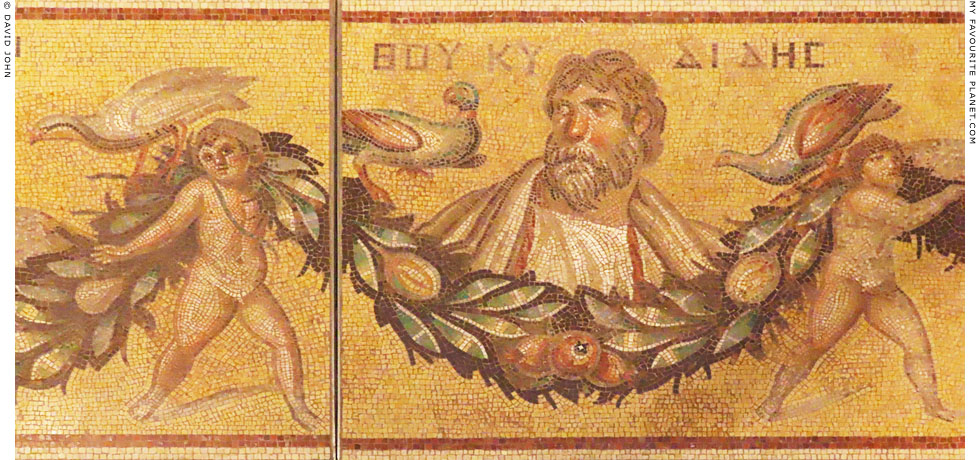
A bust of Homer on a Roman period floor mosaic from the "Villa of the Muses and Poets"
(named after the mosaic) in Gerasa (Γέρασα), today Jerash, Jordan.
Late 2nd - early 3rd century AD. Natural stone and glass tesserae. Restored 1979-1980.
Altes Museum, Berlin. Inv. No. Mos. 73. Acquired in 1908. Previously in the Pergamon Museum.
|
Part of a large polychrome floor mosaic, measuring around 380 x 440 cm, from a rectangular room of the villa, thought to have been a triclinium (dining room). It was discovered by chance in 1907 by a Circassian family living in the ruins of the ancient city, and excavated between 1907 and 1935. The twenty two fragments of the floor now in the Berlin State Museums (SMB) were purchased in 1908, following the first excavation by Gottlieb Schumacher, and parts uncovered subsequently are in other museums and private collections.
The floor mosaic had a 20 cm wide frame with a continuous guilloche pattern, enclosing a wider border within which ran a series of busts of Muses alternating with ancient Greek writers, including Thucydides and the poets Homer (see the bust in Homer part 1), as well as the poets Anakreon, Alkman and Stesichoros. Each of the busts is shown above part of a long garland, continuous along each side of the border, festooned with leaves and fruit, supported by Erotes (Cupids) and hung with theatre masks. Various birds stand on the garland, flanking the busts. At each of the four corners of the border was a round medallion containing a bust of one of the Seasons (Horai).
The centre of the mosaic is thought to have been divided into four large emblemata (panels) with depictions of Dionysian scenes with several figures: one surviving emblema shows a Triumph of Dionysus (see the Dionysus page), and another a Dionysian procession with a drunken Herakles among Satyrs, Silens and Maenads.
The Dionysian themes and the presence of the Muses has led to the suggestion that the villa's owner may have had some connection with the theatre. However, none of the surviving busts portray playwrights, and apart from the actors' masks there is no specifically theatrical imagery. It may be more likely that the central panels reflect the use of the room for symposia (drinking parties), and the Muses and writers were meant to broadcast the owner's claim to literary taste.
Thucydides' name in Greek is written in black tesserae, in two parts, ΘΟΥΚΥ ΔΙΔΗC, to either side of his head. He is depicted as a middle-aged man with long brown hair and greying beard, a red nose and cheeks, his head turned slightly to face the viewer's left. He wears a white chiton (tunic) with a vertical red stripe on each side of the chest, with a himation (cloak) over his shoulders. This lively portrait is that of a dashing intellectual in his prime, the kind one sees today in photos of authors on the back covers of books.
Among the puzzling aspects of this floor decoration is the fact that on the outer border all the portraits face the outside of the mosaic area. In order to appreciate the images and read the inscriptions, the viewer in the villa would have had to stand or sit on the narrow guilloche frame, which was at the edge of the floor next to the walls of the room. Usually the floor would have been covered by dining couches and other furniture, and perhaps carpets. This also applies to other floor mosaics in private homes, leaving us to wonder why their owners went to so much expense commissioning or buying works of art they seldom saw.
For further reading on the history of the mosaic, see the note in Homer part 1. |
|
|
| |
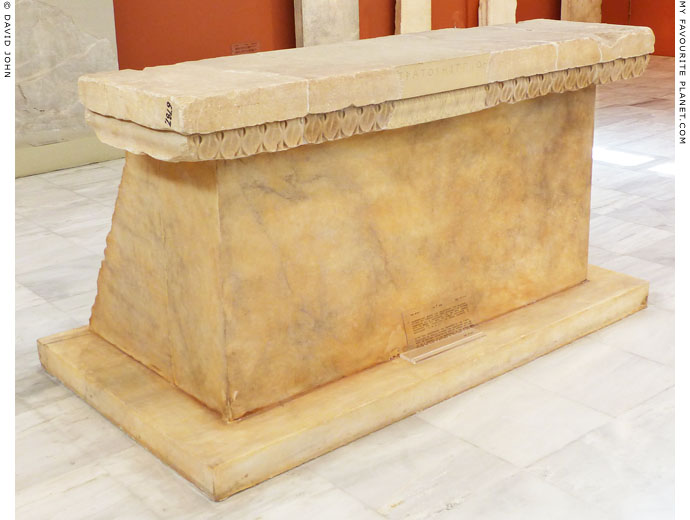
The inscribed marble crowning facia of an altar mentioned by Thucydides, set up in
the sanctuary of Apollo Pythios in Athens by Peisistratos (referred to as Peisistratos
the Younger), the grandson of the Athenian tyrant Peisistratos and son of Hippias.
Circa 522-511 BC. Crowning facia, height 18.5 cm, length 182 cm, depth 59 cm.
Epigraphical Museum, Athens. Inv. No. EM 6787.
|
"The city [Athens] meanwhile was permitted to retain her ancient laws; but the family of Pisistratus took care that one of their own number should always be in office. Among others who thus held the annual archonship at Athens was Pisistratus, a son of the tyrant Hippias. He was named after his grandfather Pisistratus, and during his term of office he dedicated the altar of the Twelve Gods in the Agora, and another altar in the temple of the Pythian Apollo.
The Athenian people afterwards added to one side of the altar in the Agora and so concealed the inscription upon it; but the other inscription on the altar of the Pythian Apollo may still be seen, although the letters are nearly effaced. It runs as follows:
Pisistratus the son of Hippias dedicated this memorial of his archonship in the sacred precinct of the Pythian Apollo."
Thucydides, History of the Peloponnesian War, Book 5, chapter 54, sections 6-7. At Perseus Digital Library.
The facia of the altar was found in five fragments during excavations in 1877 on the right (north) bank of the Ilissos River, southwest of the Olympieion (Temple of Olympian Zeus) in central Athens. The fragments included most of the inscription exactly as quoted Thucydides. A further small fragment (Inv. No. Λ 13142) was discovered in March 2009 at 3 Iosiph ton Rogon Street (Οδός Ιωσήφ Των Ρωγών), near the site of the earlier excavations. It fitted perfectly a missing section of the top front edge of the altar and completed the part of the dedicatory inscription mentioning Apollo Pythios.
Μνε̃μα τόδε hε̃ς ἀρχε̃ς Πεισίστ[ρατος hιππίο h]υιὸς θε̃κεν Ἀπόλλονος Πυθίο ἐν τεμένει.
This memorial of his archonship Peisistratos son of Hippias set up in the temenos of Apollo Pythios.
Inscription Inscription IG I³ 948.
It is not known in which year Peisistratos (Πεισίστρατος) was archon, some time between 522 and 511 BC, perhaps 522/521 BC. The location of the sanctuary of Apollo Pythios (Απόλλων Πύθιος) has not yet been found, but is thought to be beneath modern buildings in the area where the altar fragments and other artefacts have been found.
The Altar of the Twelve Gods (or the Sanctuary of the Twelve Gods) at the northwest of the Athens Agora, was considered the centre of the city and the point from which distances from other places were measured. [3] The extension of the altar mentioned by Thucydides was probably built around the last third of the 5th century BC, during the Peloponnesian War.
For further information about the Twelve Great Gods of Olympus, known as the Dodekatheon (Δωδεκάθεον), see Dionysus and Demeter and Persephone part 2. |
|
|
| |
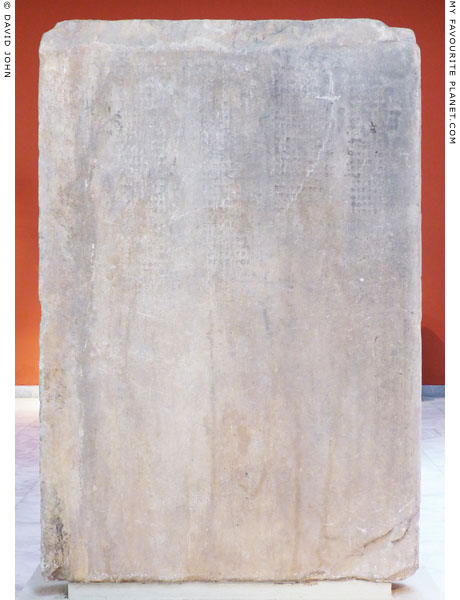
A marble stele inscribed with an Athenian casualty list, thought
to record some of the names of those who died during the
disastrous military expedition to Sicily 415-413 BC, during
the Peloponnesian War, which was described by Thucydides.
Around 411 BC.
Epigraphical Museum, Athens. Inv. No. EM 13190.
Inscription IG I³ 1186b.
|
Thucydides is the main historical source concerning the Athenian Sicilian expedition, which ended with the entire expeditionary force being killed or captured, with many being sold as slaves. His account, which takes up most of Books 6 and 7 of the History of the Peloponnesian War, also includes valuable and rare information about the history of ancient Sicily. He may have used now lost histories of Sicily and Italy by Antiochus of Syracuse as sources, particularly concerning the Greek colonization there.
Another stele exhibited in the Epigraphical Museum is also believed to be a casualty list of the Sicilian expedition. Inv. No. EM 10617. Inscription IG I(3) 1186a. However, it has been argued that these steles do not refer to the Sicilian campaign. |
|
| |
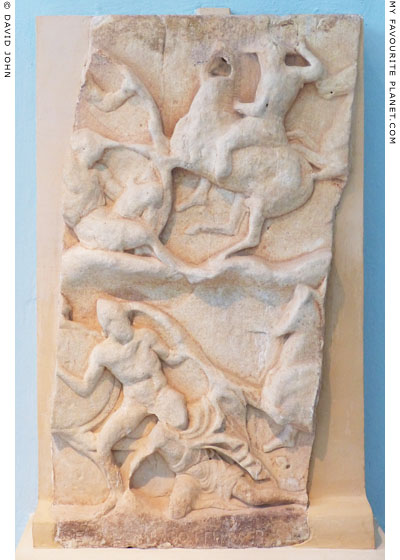
The inscribed relief of Pythodoros, son of Epizelos,
with a depiction in two zones of a battle between
Athenian cavalry and Spartan infantry.
Last quarter of the 5th century BC.
Eleusis Archaeological Museum. Inv. No. 5101. |
| |
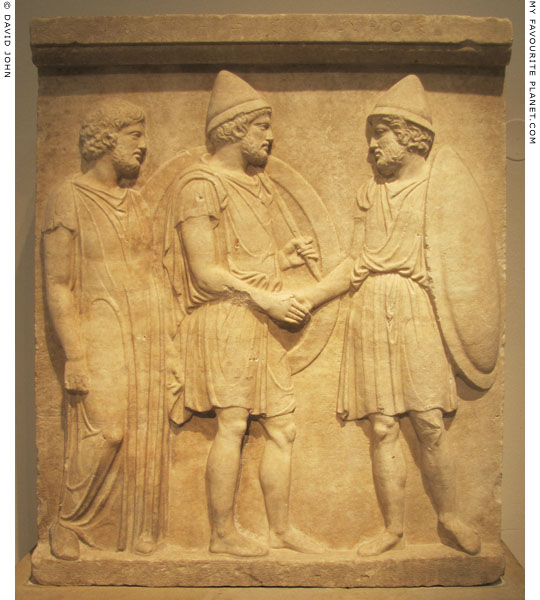
The funerary relief of Sosias and Kephisodoros, from the time of the final phase
of the Peloponnesian War. Two Athenian citizen soldiers, with large round shields
and cone-shaped pilos helmets (see Medusa part 6), shake hands in farewell.
On the left, the bearded man in the robes of an Athenian priest may have been
a seer who was consulted before a battle.
Marble. Around 410 BC.
Altes Museum, Berlin. Inv. No. Sk 1708. Acquired in 1910 in Paris. |
| |
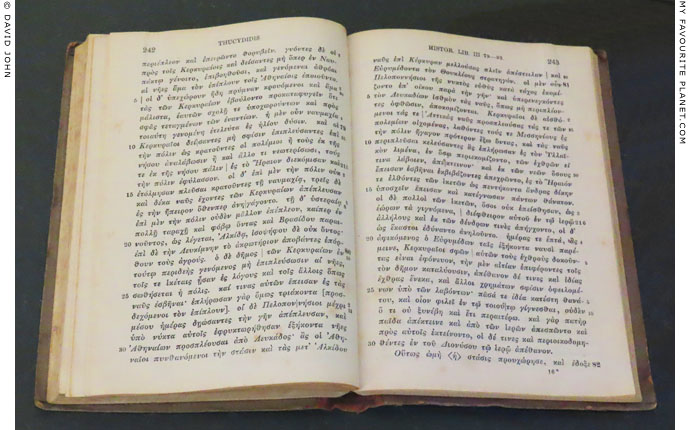
A modern edition of Thucydides' History of the Peloponnesian War in Greek as a museum exhibit.
The book is open at Book 3, chapters 79-82, dealing with a naval battle fought by
the Korkyreans and Athenians against the Peloponnesians in summer 427 BC, and
the civil war in Korkyra (Corfu). Thucydides' description of a naval battle between
Korkyra and the colony's metropolis (mother city) Corinth in 665/664 BC (Book 1,
chapter 3) is the earliest surviving record of a sea battle between Greek city states.
Corfu Archaeological Museum. |
| |
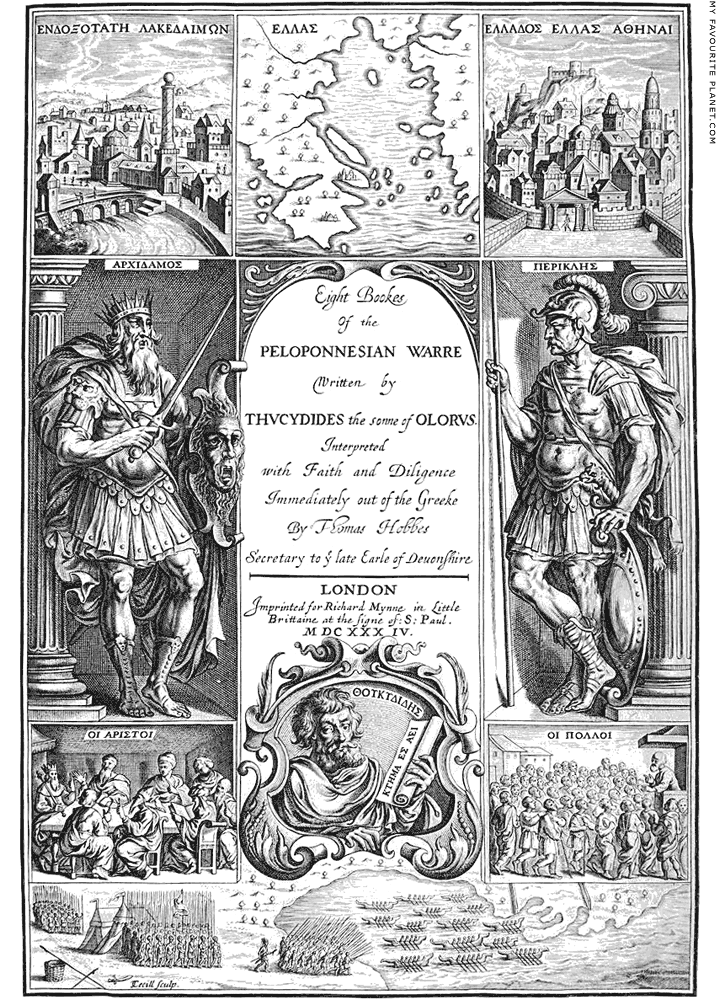
The illustrated title page of the 1634 edition of the first English translation
of Thucydides' History of the Peloponnesian War by the political philosopher
Thomas Hobbes (1588-1679), first published in 1628.
"The eight Bookes of the Peloponnesian Warre, written by Thucydides the sonne of Olorus.
Interpreted with faith and diligence immediately out of the Greeke by Thomas Hobbes,
secretary to ye late Earl of Devonshire. London. Imprinted for Richard Mynne in Little
Brittaine at the Sign of Saint Paul. MDCXXXIV (1634)." At the Internet Archive. |
| |
| Thucydides |
Notes, references and links |
 |
|
1. Scapte Hyle (Σκαπτὴ Ὕλη, a forest that may be dug; also referred to as Scaptensula, foss wood).
"Indeed the Muses, it appears, called exile to their aid in perfecting for the ancients the finest and most esteemed of their writings. 'Thucydides of Athens composed the history of the war of the Peloponnesians and Athenians' in Thrace at Scapte Hyle; Xenophon wrote at Scillus in Elis, Philistus in Epeirus, Timaeus of Tauromenium at Athens, Androtion of Athens at Megara, and the poet Bacchylides in the Peloponnese."
Plutarch, Moralia, On Exile, section 14. English translation by Phillip H. De Lacy and Benedict Einarson. Loeb Classical Library, 1959. At Bill Thayer's LacusCurtius website, University of Chicago.
See also:
Thucydides, The Peloponnesian War, Book 4, chapter 105, section 1.
Plutarch, Lives, Cimon, Chapter 4.
Both at Perseus Digital Library.
2. Xenophon of Athens (Ξενοφῶν, circa 430-354 BC), general, historian and philosopher; pupil of Socrates.
A profile of Xenophon will appear in this section at some point. Meanwhile, read an anecdote by the author about his military adventure in Pergamon on History of Pergamon.
3.The Altar of the Twelve Gods in Athens
The altar ("δυώδεκα θεῶν τοῦ βωμοῦ") was also mentioned by Herodotus, The Histories, Book 2, chapter 7, section 1, and Book 6, chapter 108, section 4. |
|
|
| Photos and articles © David John, except where otherwise specified. |
 |
Visit the My Favourite Planet Group on Facebook.
Join the group, write a message or comment,
post photos and videos, start a discussion... |
|
|
| |
| Copyright © 2003-2025 My Favourite Planet | contributors | impressum | contents | sitemap |
| |






















